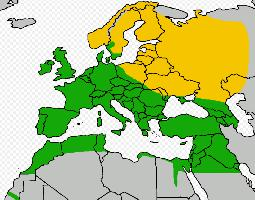
Weights and measures
| Weight | from 180 to 220 g |
|---|---|
| Wingspan | from 68 to 80 cm |
State of endangerment
| Non Endangered |
Animal description
The Common Kestrel (Falco tinnunculus), also known simply as the kestrel, is a bird of prey that belongs to the falcon family Falconidae. It is a widespread species that is found across Europe, Asia, and Africa, and is notable for its adaptability to various environments, including farmlands, cities, and forests.Adult Common Kestrels typically measure about 32 to 39 cm in length with a wingspan ranging from 65 to 82 cm. They exhibit sexual dimorphism, which means males and females have different physical appearances. Males tend to have a slate-blue head and tail with a black terminal band, while their back and upperwings are a rich, chestnut color with black spots. The underparts are cream-colored with black spots that are more pronounced in females. Females, on the other hand, have more uniformly brown upperparts with darker streaks and a similar pattern below but with a more rufous hue.
One of the most distinctive behaviors of the Common Kestrel is its hunting technique. It is known for its ability to hover mid-air with rapid wing beats and an almost motionless body as it scans the ground below for prey. This remarkable skill allows it to spot small mammals like voles, mice, and shrews, which are its primary diet, as well as birds, insects, and reptiles.
Kestrels have excellent vision, with the ability to see ultraviolet light, which helps them to detect the urine trails left by rodents in the grass, making these prey animals easier to find. When a kestrel spots its prey, it will dive toward the ground with incredible speed and precision to capture it with its sharp talons.
During the breeding season, which typically occurs from April to July, kestrels become more territorial. They prefer to nest in cavities, often utilizing old crow's nests, cliff ledges, or even building ledges in urban areas. The female lays between 3 to 6 eggs, and both parents take part in incubation, which lasts about 28 to 30 days. The chicks are altricial, meaning they are born blind and helpless, and require extensive parental care. They fledge after approximately 4 to 5 weeks but may remain dependent on their parents for several more weeks.
The Common Kestrel's call is a loud "kee-kee-kee," especially uttered during the breeding season and when alarmed. Its flight is agile and graceful, with the ability to navigate through the air with ease and perform rapid turns and dives.
As a species, the Common Kestrel is currently listed as Least Concern by the International Union for Conservation of Nature (IUCN) due to its wide distribution and large population. However, it is not immune to threats such as habitat loss, pesticide use, and collision with vehicles and buildings. Conservation efforts continue to monitor kestrel populations and ensure the preservation of their habitats to maintain their numbers in the wild.
Map of occurrence

Similar Animals
New photos of animals
Top 10 animals
- Dolphin gull (Leucophaeus scoresbii)
- Japanese macaque (Macaca fuscata)
- Stone loach (Barbatula barbatula)
- Galápagos tortoise (Geochelone nigra complex)
- Diana monkey (Cercopithecus diana)
- Russian tortoise (Testudo horsfieldii)
- Moustached guenon (Cercopithecus cephus)
- Greek tortoise (Testudo graeca)
- Common flying dragon (Draco volans)
- Common house mosquito (Culex pipiens)


